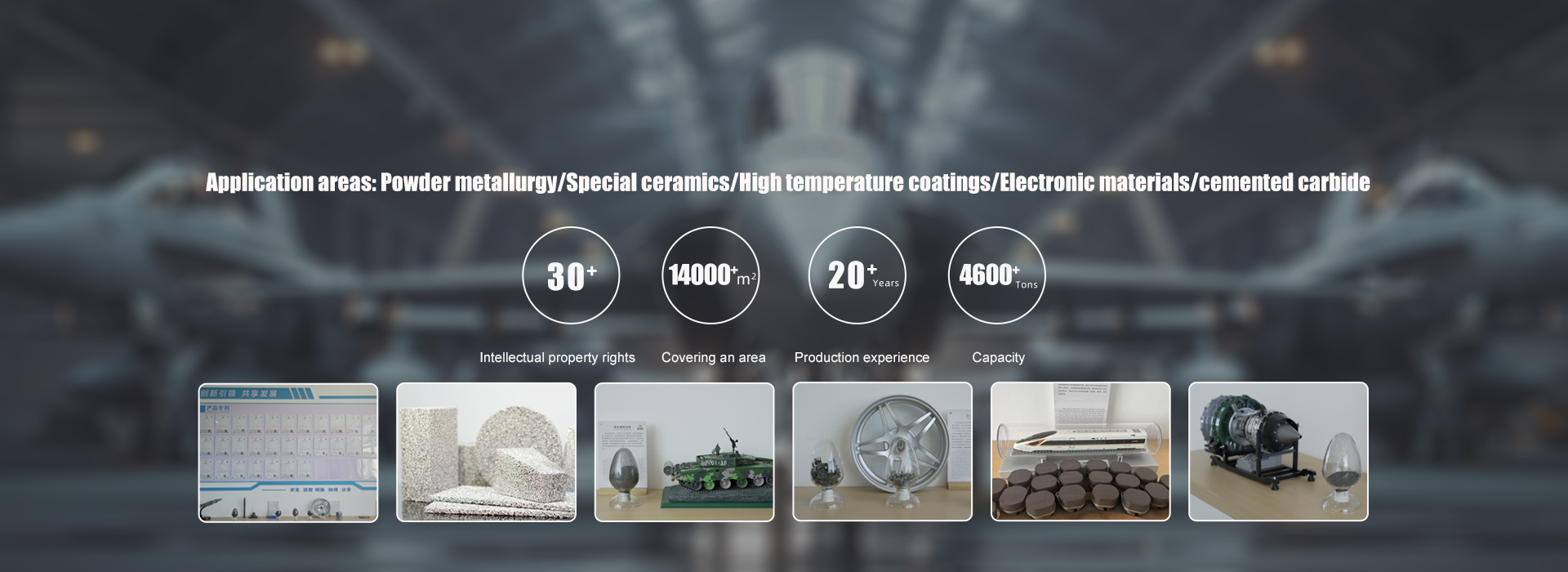
1. Ultra high temperature ceramics
Ultra high temperature ceramics refer to a special material that can maintain physical and chemical stability in high-temperature environments (2000 ℃) and reaction atmospheres (such as atomic oxygen environments). It is a ceramic based composite material with excellent high-temperature mechanical properties, high-temperature oxidation resistance, and thermal shock resistance. Ultra high temperature ceramics are mainly composed of high melting point borides and carbides, including hafnium boride (HfB2), zirconium boride (ZrB2), hafnium carbide (HfC), zirconium carbide (ZrC), tantalum carbide (TaC), etc. The melting points of borides and carbides in ultra-high temperature ceramics exceed 3000 ℃, and they have excellent thermochemical stability and physical properties, including high elastic modulus, high hardness, low saturation vapor pressure, moderate thermal expansion rate, and good thermal shock resistance. They can also maintain high strength at high temperatures. Ultra high temperature ceramics can adapt to extreme environments such as long-term flight at ultra-high speeds, atmospheric reentry, cross atmospheric flight, and rocket propulsion systems. They can be applied to various key components such as aircraft nose cones, wing leading edges, and engine hot ends. As an important material applied in aerospace vehicles, ultra-high temperature ceramic materials have received high attention from various countries.
The properties of common carbides and borides
1.1 Research progress of ultra-high temperature ceramics
The research on ultra-high temperature ceramic materials abroad began in the early 1960s. With strong support from the US Department of Defense, Manlab began to study ultra-high temperature ceramic materials, mainly focusing on ZrB2, HfB2 and their composite materials. The 80 vol% HfB2-20 vol% SiC composite material developed by Manlab can basically meet the requirements for continuous use in high-temperature oxidation environments, providing great assistance for the analysis and design of sharp leading edge aircraft and their thermal protection systems. In the 1990s, NASA Ames Laboratory began conducting research on ultra-high temperature ceramic materials. Ames Laboratory and related partners carried out a series of research work on system thermal analysis, material development, and arc heater testing, and conducted two flight experiments (SHARP-B1, SHARP-B2). Among them, the sharp wing leading edge in the SHARP-B2 flight experiment is divided into three parts due to different thermal environments, using ZrB2/SiC/C, ZrB2/SiC, and HfB2/SiC materials respectively. The experimental results indicate that ultra-high temperature ceramic materials mainly composed of hafnium diboride (HfB2) and zirconium diboride (ZrB2) can be used as thermal protection system materials for hypersonic aircraft in the atmosphere, and their application prospects are immeasurable. In early February 2003, the American space shuttle Columbia experienced a shocking explosion tragedy. In order to improve the flight safety of future space shuttles and prevent similar tragedies as the Columbia explosion from happening again, NASA quickly launched relevant research plans after the Columbia disaster, including focused research and development of a new generation of ultra-high temperature ceramics with melting points above 3000 ℃ as thermal insulation materials for future space shuttles.
Domestic research on ultra-high temperature ceramic materials is equally valued. At the 2014 International Forum on the Development Trends of New Materials, Academician Li Zhongping emphasized the need to accelerate the research and development of high-performance and low-cost SiC precursors and SiC fibers, and to accelerate the basic research and application of carbide ultra-high temperature ceramics. Professor Cheng Laifei from Northwestern Polytechnical University introduced the research progress of SiCw/SiC layered structure ceramics. Academician Zhang Litong's research group used processes such as CVI, PIP, and RMI to prepare Cf/SiC ceramic matrix composites. At the same time, the concept of interface region was proposed, and a physical model of the interaction between matrix cracks and interface region in Cf/SiC was established. The service performance of the composites was systematically evaluated. Professor Dong Shaoming from the Chinese Academy of Sciences Shanghai Institute of Silicate introduced the preparation of carbide and nitride ceramic matrix composites by in-situ reaction method. He tried to add boron, aluminum and other additives in the preparation of Cf/SiC and SiCf/SiC composites through the PIP process to shorten the densification time of PIP, improve the oxidation resistance and mechanical properties. At present, domestically produced ultra-high temperature ceramic materials are gradually being applied in China's aerospace industry.
1.2 Boride ultra-high temperature ceramics
Ultra high temperature borides mainly include hafnium boride (HfB2), zirconium boride (ZrB2), tantalum boride (TaB2), and titanium boride (TiB2). Currently, research on zirconium boride (ZrB2) and hafnium boride (HfB2) is the most concentrated. Boride ultra-high temperature ceramics (UHTCs) are composed of strong covalent bonds and have characteristics such as high melting point, high hardness, high strength, low evaporation rate, high thermal conductivity, and electrical conductivity. However, the strong covalent bonds make them difficult to sinter and densify. In order to improve its sintering performance and increase its density, methods such as increasing the surface energy of reactants, reducing the grain boundary energy of products, increasing the bulk diffusion rate of materials, accelerating the transport rate of substances, and improving mass transfer kinetics can be used to solve the problem.
Single phase zirconium boride (ZrB2) and hafnium boride (HfB2) exhibit good oxidation resistance below 1200 ℃, due to the formation of liquid boron oxide (B2O3) glass phase on the surface, which provides excellent oxidation protection. In the oxidation process of zirconium boride (ZrB2), zirconium boride (ZrB2) oxidizes to form zirconium oxide (ZrO2) and boron oxide (B2O3), forming an antioxidant protective layer that prevents the oxidation of zirconium boride (ZrB2). When the temperature exceeds the melting point of boron oxide (B2O3) (450 ℃), boron oxide (B2O3) slowly evaporates. The higher the temperature, the faster the evaporation rate of boron oxide (B2O3), and its role as an oxygen diffusion barrier layer is lower, resulting in a decrease in the antioxidant performance of borides. Parthasarathy et al. studied the oxidation of zirconium boride (ZrB2), hafnium boride (HfB2), and titanium boride (TiB2) at temperatures ranging from 1000 to 1800 ° C. They found that below 1400 ° C, the oxidation kinetics of borides follow a parabolic pattern, with metal atom oxides forming the skeleton, and the resulting liquid boron oxide filling the skeleton and coating the boride surface. At this point, the oxidation rate is controlled by the diffusion of oxygen through liquid boron oxide (B2O3). During the high temperature stage, the diffusion process of oxygen vacancies through the oxide lattice constrains the oxidation rate.
The ZrB2 SiC composite material prepared by adding silicon carbide (SiC) has better comprehensive properties, such as higher binary eutectic temperature and good oxidation resistance. Clougherty et al. introduced silicon carbide (SiC) into zirconium boride (ZrB2) and hafnium boride (HfB2) in the 1960s, initially with the aim of refining grains and improving strength. After adding silicon carbide (SiC), the outermost layer of boride surface at high temperature is mainly composed of a glass layer rich in silicon dioxide (SiO2), and the inner layer is an oxide layer (ZrO2, HfO2). The glass layer can prevent oxygen diffusion, so zirconium boride (ZrB2) still has high oxidation resistance at 2000 ℃ after adding 20-30% volume ratio of silicon carbide (SiC). Sun et al. studied the effect of zirconia (ZrO2) fiber toughening on ZrB2 SiC composite materials. The elastic strength and fracture toughness of ZrB2 SiC ZrO2f ceramics prepared by hot pressing at 1850 ℃ were 1086 ± 79 MPa and 6.9 ± 0.4 MPa · m1/2, respectively. At high temperatures, a borosilicate protective layer is formed on the surface of ZrB2 SiC composite materials, which can maintain its parabolic oxidation law to over 1600 ℃. Some additives, such as molybdenum silicide (MoSi2), zirconium silicide (ZrSi2), tantalum silicide (TaSi2), tantalum boride (TaB2), etc., are also used to improve the oxidation resistance of zirconium boride (ZrB2) and hafnium boride (HfB2). The addition of the second phase forms a high melting point glass phase on the surface of the material at high temperatures, preventing the diffusion of oxygen into the interior of the material and improving its high-temperature oxidation resistance.
1.3 Carbide ultra-high temperature ceramics
Carbide ultra-high temperature ceramics have high melting points, high strength, high hardness, and good chemical stability, making them widely used ultra-high temperature ceramic materials. Currently, commonly used carbide ultra-high temperature ceramics mainly include silicon carbide (SiC), zirconium carbide (ZrC), tantalum carbide (TaC), and hafnium carbide (HfC). Hafnium carbide (HfC), zirconium carbide (ZrC), and tantalum carbide (TaC) have much higher melting points compared to their oxides, do not undergo any solid-phase phase transition, have good thermal shock resistance, and still have high strength at high temperatures. However, the fracture toughness and oxidation resistance of such carbide ultra-high temperature ceramics are relatively low, and fibers are usually used for reinforcement and toughening.
The oxidation of ultra-high temperature carbides is a comprehensive process in which oxygen diffuses internally or metal ions diffuse externally, and gaseous or liquid by-products (under relatively low temperature conditions) escape to the outside through the oxide layer. The oxidation resistance of ultra-high temperature carbides is mainly affected by the formation and release of gaseous by-products during the oxidation process, such as CO and CO2. In carbide ultra-high temperature ceramics, zirconium carbide (ZrC) is relatively inexpensive and has high melting point, high hardness and other properties, making it a very promising ultra-high temperature material. Single phase zirconium carbide (ZrC) has poor oxidation resistance at high temperatures; When heated to 800 ℃ in air, it begins to undergo severe oxidation, forming zirconia (ZrO2) and carbon (C); When the temperature rises to 1100 ℃, carbon (C) continues to react with oxygen (O2) to produce carbon monoxide (CO) or carbon dioxide (CO2). The research results show that hafnium carbide (HfC), zirconium carbide (ZrC), and tantalum carbide (TaC) absorb a large amount of oxygen into the lattice, and the oxidation zone formed at high temperatures includes at least 2 layers; One layer is an internal oxide layer with very few voids, and the other layer is a porous external oxide layer that cannot prevent oxygen diffusion. Therefore, single-phase zirconium carbide (ZrC) has poor oxidation resistance, so it is generally used in combination with other materials such as ZrC-Mo-Si2, ZrC-ZrB2, ZrC SiC, ZrC-ZrO2, and ZrC Mo. Savino et al. added 5% volume fraction of molybdenum silicide (MoSi2) to hafnium carbide (HfC) and found that MoSi2 promoted sintering, resulting in a sintered body density of 98% of the theoretical density with few voids. The surface layer is a multi-layer structure with cracks, but it is firmly bonded with unreacted hafnium carbide (HfC) in the bottom layer. The outermost layer is still porous hafnium oxide (HfO2), and no continuous glass phase has been found. The second phase additive not only improves the oxidation resistance and sintering performance of zirconium carbide (ZrC) and hafnium carbide (HfC), but also effectively suppresses the growth of matrix grains, introduces residual stresses, and enhances the strength and toughness of the material. In addition, Al and Cr can oxidize into dense aluminum oxide (Al2O3) and chromium oxide (Cr2O3) films at high temperatures. Liu Dongliang used first principles to compare the formation energies of Al and Cr doped hafnium carbide (HfC). He found that the stability of Cr doped hafnium carbide (HfC) was better than that of Al doped.
The sintering properties and density of carbon oxides have a significant impact on the diffusion of oxygen. Borosilicate glass is relatively dense compared to metal carbon oxides and has a better inhibitory effect on oxygen diffusion. This is also one of the reasons why silicon doped boride ultra-high temperature ceramics have been widely studied so far.
2. Conclusion
At present, China has made significant breakthroughs in the field of ultra-high temperature materials, but there are still many unresolved issues in the research of ultra-high temperature materials. In the future, research on ultra-high temperature materials should focus on strengthening the following aspects:
(1) Strengthen research on modifying the matrix of C/C composite materials. At present, most of the research on matrix modification of C/C composite materials is carried out in small samples. The research object should be changed from small samples to application components for specific application components. Efforts should be made to improve the stability of the preparation process, the portability of matrix modification measures, and the coordination of the comprehensive performance of the components.
(2) Study atomic oxygen using material calculation methods. This method can avoid oxidation caused by the contact between materials and atomic oxygen in conventional experiments; Using fluid dynamics methods to simulate the phenomenon of fluid flow around materials and explore the oxidation mechanism of ultra-high temperature ceramic materials from these aspects.
(3) Conduct research on the surface of ultra-high temperature ceramic materials. How molecular oxygen and atomic oxygen bind and diffuse on the surface of these ceramic materials, and explore how to prevent the binding and diffusion of oxygen on the surface of ultra-high temperature ceramics.
(4) Explore measures to improve the toughness of ultra-high temperature ceramic materials. For example, can nanowires, nanobelts, and nanorods be introduced into carbides, borides, and their composite ceramics to explore whether and how they can improve the toughness of ultra-high temperature ceramics.
(5) Addressing the issue of defect control in ultra-high temperature ceramic materials. Defects cannot be avoided in ultra-high temperature ceramic materials, and at the same time, defects have a significant impact on the performance of ultra-high temperature ceramic materials. Therefore, exploring the causes of defect formation and its detection, characterization, and control techniques and methods is one of the directions for future research.1. Ultra high temperature ceramics
Ultra high temperature ceramics refer to a special material that can maintain physical and chemical stability in high-temperature environments (2000 ℃) and reaction atmospheres (such as atomic oxygen environments). It is a ceramic based composite material with excellent high-temperature mechanical properties, high-temperature oxidation resistance, and thermal shock resistance. Ultra high temperature ceramics are mainly composed of high melting point borides and carbides, including hafnium boride (HfB2), zirconium boride (ZrB2), hafnium carbide (HfC), zirconium carbide (ZrC), tantalum carbide (TaC), etc. The melting points of borides and carbides in ultra-high temperature ceramics exceed 3000 ℃, and they have excellent thermochemical stability and physical properties, including high elastic modulus, high hardness, low saturation vapor pressure, moderate thermal expansion rate, and good thermal shock resistance. They can also maintain high strength at high temperatures. Ultra high temperature ceramics can adapt to extreme environments such as long-term flight at ultra-high speeds, atmospheric reentry, cross atmospheric flight, and rocket propulsion systems. They can be applied to various key components such as aircraft nose cones, wing leading edges, and engine hot ends. As an important material applied in aerospace vehicles, ultra-high temperature ceramic materials have received high attention from various countries.
The properties of common carbides and borides
1.1 Research progress of ultra-high temperature ceramics
The research on ultra-high temperature ceramic materials abroad began in the early 1960s. With strong support from the US Department of Defense, Manlab began to study ultra-high temperature ceramic materials, mainly focusing on ZrB2, HfB2 and their composite materials. The 80 vol% HfB2-20 vol% SiC composite material developed by Manlab can basically meet the requirements for continuous use in high-temperature oxidation environments, providing great assistance for the analysis and design of sharp leading edge aircraft and their thermal protection systems. In the 1990s, NASA Ames Laboratory began conducting research on ultra-high temperature ceramic materials. Ames Laboratory and related partners carried out a series of research work on system thermal analysis, material development, and arc heater testing, and conducted two flight experiments (SHARP-B1, SHARP-B2). Among them, the sharp wing leading edge in the SHARP-B2 flight experiment is divided into three parts due to different thermal environments, using ZrB2/SiC/C, ZrB2/SiC, and HfB2/SiC materials respectively. The experimental results indicate that ultra-high temperature ceramic materials mainly composed of hafnium diboride (HfB2) and zirconium diboride (ZrB2) can be used as thermal protection system materials for hypersonic aircraft in the atmosphere, and their application prospects are immeasurable. In early February 2003, the American space shuttle Columbia experienced a shocking explosion tragedy. In order to improve the flight safety of future space shuttles and prevent similar tragedies as the Columbia explosion from happening again, NASA quickly launched relevant research plans after the Columbia disaster, including focused research and development of a new generation of ultra-high temperature ceramics with melting points above 3000 ℃ as thermal insulation materials for future space shuttles.
Domestic research on ultra-high temperature ceramic materials is equally valued. At the 2014 International Forum on the Development Trends of New Materials, Academician Li Zhongping emphasized the need to accelerate the research and development of high-performance and low-cost SiC precursors and SiC fibers, and to accelerate the basic research and application of carbide ultra-high temperature ceramics. Professor Cheng Laifei from Northwestern Polytechnical University introduced the research progress of SiCw/SiC layered structure ceramics. Academician Zhang Litong's research group used processes such as CVI, PIP, and RMI to prepare Cf/SiC ceramic matrix composites. At the same time, the concept of interface region was proposed, and a physical model of the interaction between matrix cracks and interface region in Cf/SiC was established. The service performance of the composites was systematically evaluated. Professor Dong Shaoming from the Chinese Academy of Sciences Shanghai Institute of Silicate introduced the preparation of carbide and nitride ceramic matrix composites by in-situ reaction method. He tried to add boron, aluminum and other additives in the preparation of Cf/SiC and SiCf/SiC composites through the PIP process to shorten the densification time of PIP, improve the oxidation resistance and mechanical properties. At present, domestically produced ultra-high temperature ceramic materials are gradually being applied in China's aerospace industry.
1.2 Boride ultra-high temperature ceramics
Ultra high temperature borides mainly include hafnium boride (HfB2), zirconium boride (ZrB2), tantalum boride (TaB2), and titanium boride (TiB2). Currently, research on zirconium boride (ZrB2) and hafnium boride (HfB2) is the most concentrated. Boride ultra-high temperature ceramics (UHTCs) are composed of strong covalent bonds and have characteristics such as high melting point, high hardness, high strength, low evaporation rate, high thermal conductivity, and electrical conductivity. However, the strong covalent bonds make them difficult to sinter and densify. In order to improve its sintering performance and increase its density, methods such as increasing the surface energy of reactants, reducing the grain boundary energy of products, increasing the bulk diffusion rate of materials, accelerating the transport rate of substances, and improving mass transfer kinetics can be used to solve the problem.
Single phase zirconium boride (ZrB2) and hafnium boride (HfB2) exhibit good oxidation resistance below 1200 ℃, due to the formation of liquid boron oxide (B2O3) glass phase on the surface, which provides excellent oxidation protection. In the oxidation process of zirconium boride (ZrB2), zirconium boride (ZrB2) oxidizes to form zirconium oxide (ZrO2) and boron oxide (B2O3), forming an antioxidant protective layer that prevents the oxidation of zirconium boride (ZrB2). When the temperature exceeds the melting point of boron oxide (B2O3) (450 ℃), boron oxide (B2O3) slowly evaporates. The higher the temperature, the faster the evaporation rate of boron oxide (B2O3), and its role as an oxygen diffusion barrier layer is lower, resulting in a decrease in the antioxidant performance of borides. Parthasarathy et al. studied the oxidation of zirconium boride (ZrB2), hafnium boride (HfB2), and titanium boride (TiB2) at temperatures ranging from 1000 to 1800 ° C. They found that below 1400 ° C, the oxidation kinetics of borides follow a parabolic pattern, with metal atom oxides forming the skeleton, and the resulting liquid boron oxide filling the skeleton and coating the boride surface. At this point, the oxidation rate is controlled by the diffusion of oxygen through liquid boron oxide (B2O3). During the high temperature stage, the diffusion process of oxygen vacancies through the oxide lattice constrains the oxidation rate.
The ZrB2 SiC composite material prepared by adding silicon carbide (SiC) has better comprehensive properties, such as higher binary eutectic temperature and good oxidation resistance. Clougherty et al. introduced silicon carbide (SiC) into zirconium boride (ZrB2) and hafnium boride (HfB2) in the 1960s, initially with the aim of refining grains and improving strength. After adding silicon carbide (SiC), the outermost layer of boride surface at high temperature is mainly composed of a glass layer rich in silicon dioxide (SiO2), and the inner layer is an oxide layer (ZrO2, HfO2). The glass layer can prevent oxygen diffusion, so zirconium boride (ZrB2) still has high oxidation resistance at 2000 ℃ after adding 20-30% volume ratio of silicon carbide (SiC). Sun et al. studied the effect of zirconia (ZrO2) fiber toughening on ZrB2 SiC composite materials. The elastic strength and fracture toughness of ZrB2 SiC ZrO2f ceramics prepared by hot pressing at 1850 ℃ were 1086 ± 79 MPa and 6.9 ± 0.4 MPa · m1/2, respectively. At high temperatures, a borosilicate protective layer is formed on the surface of ZrB2 SiC composite materials, which can maintain its parabolic oxidation law to over 1600 ℃. Some additives, such as molybdenum silicide (MoSi2), zirconium silicide (ZrSi2), tantalum silicide (TaSi2), tantalum boride (TaB2), etc., are also used to improve the oxidation resistance of zirconium boride (ZrB2) and hafnium boride (HfB2). The addition of the second phase forms a high melting point glass phase on the surface of the material at high temperatures, preventing the diffusion of oxygen into the interior of the material and improving its high-temperature oxidation resistance.
1.3 Carbide ultra-high temperature ceramics
Carbide ultra-high temperature ceramics have high melting points, high strength, high hardness, and good chemical stability, making them widely used ultra-high temperature ceramic materials. Currently, commonly used carbide ultra-high temperature ceramics mainly include silicon carbide (SiC), zirconium carbide (ZrC), tantalum carbide (TaC), and hafnium carbide (HfC). Hafnium carbide (HfC), zirconium carbide (ZrC), and tantalum carbide (TaC) have much higher melting points compared to their oxides, do not undergo any solid-phase phase transition, have good thermal shock resistance, and still have high strength at high temperatures. However, the fracture toughness and oxidation resistance of such carbide ultra-high temperature ceramics are relatively low, and fibers are usually used for reinforcement and toughening.
The oxidation of ultra-high temperature carbides is a comprehensive process in which oxygen diffuses internally or metal ions diffuse externally, and gaseous or liquid by-products (under relatively low temperature conditions) escape to the outside through the oxide layer. The oxidation resistance of ultra-high temperature carbides is mainly affected by the formation and release of gaseous by-products during the oxidation process, such as CO and CO2. In carbide ultra-high temperature ceramics, zirconium carbide (ZrC) is relatively inexpensive and has high melting point, high hardness and other properties, making it a very promising ultra-high temperature material. Single phase zirconium carbide (ZrC) has poor oxidation resistance at high temperatures; When heated to 800 ℃ in air, it begins to undergo severe oxidation, forming zirconia (ZrO2) and carbon (C); When the temperature rises to 1100 ℃, carbon (C) continues to react with oxygen (O2) to produce carbon monoxide (CO) or carbon dioxide (CO2). The research results show that hafnium carbide (HfC), zirconium carbide (ZrC), and tantalum carbide (TaC) absorb a large amount of oxygen into the lattice, and the oxidation zone formed at high temperatures includes at least 2 layers; One layer is an internal oxide layer with very few voids, and the other layer is a porous external oxide layer that cannot prevent oxygen diffusion. Therefore, single-phase zirconium carbide (ZrC) has poor oxidation resistance, so it is generally used in combination with other materials such as ZrC-Mo-Si2, ZrC-ZrB2, ZrC SiC, ZrC-ZrO2, and ZrC Mo. Savino et al. added 5% volume fraction of molybdenum silicide (MoSi2) to hafnium carbide (HfC) and found that MoSi2 promoted sintering, resulting in a sintered body density of 98% of the theoretical density with few voids. The surface layer is a multi-layer structure with cracks, but it is firmly bonded with unreacted hafnium carbide (HfC) in the bottom layer. The outermost layer is still porous hafnium oxide (HfO2), and no continuous glass phase has been found. The second phase additive not only improves the oxidation resistance and sintering performance of zirconium carbide (ZrC) and hafnium carbide (HfC), but also effectively suppresses the growth of matrix grains, introduces residual stresses, and enhances the strength and toughness of the material. In addition, Al and Cr can oxidize into dense aluminum oxide (Al2O3) and chromium oxide (Cr2O3) films at high temperatures. Liu Dongliang used first principles to compare the formation energies of Al and Cr doped hafnium carbide (HfC). He found that the stability of Cr doped hafnium carbide (HfC) was better than that of Al doped.
The sintering properties and density of carbon oxides have a significant impact on the diffusion of oxygen. Borosilicate glass is relatively dense compared to metal carbon oxides and has a better inhibitory effect on oxygen diffusion. This is also one of the reasons why silicon doped boride ultra-high temperature ceramics have been widely studied so far.
2. Conclusion
At present, China has made significant breakthroughs in the field of ultra-high temperature materials, but there are still many unresolved issues in the research of ultra-high temperature materials. In the future, research on ultra-high temperature materials should focus on strengthening the following aspects:
(1) Strengthen research on modifying the matrix of C/C composite materials. At present, most of the research on matrix modification of C/C composite materials is carried out in small samples. The research object should be changed from small samples to application components for specific application components. Efforts should be made to improve the stability of the preparation process, the portability of matrix modification measures, and the coordination of the comprehensive performance of the components.
(2) Study atomic oxygen using material calculation methods. This method can avoid oxidation caused by the contact between materials and atomic oxygen in conventional experiments; Using fluid dynamics methods to simulate the phenomenon of fluid flow around materials and explore the oxidation mechanism of ultra-high temperature ceramic materials from these aspects.
(3) Conduct research on the surface of ultra-high temperature ceramic materials. How molecular oxygen and atomic oxygen bind and diffuse on the surface of these ceramic materials, and explore how to prevent the binding and diffusion of oxygen on the surface of ultra-high temperature ceramics.
(4) Explore measures to improve the toughness of ultra-high temperature ceramic materials. For example, can nanowires, nanobelts, and nanorods be introduced into carbides, borides, and their composite ceramics to explore whether and how they can improve the toughness of ultra-high temperature ceramics.
(5) Addressing the issue of defect control in ultra-high temperature ceramic materials. Defects cannot be avoided in ultra-high temperature ceramic materials, and at the same time, defects have a significant impact on the performance of ultra-high temperature ceramic materials. Therefore, exploring the causes of defect formation and its detection, characterization, and control techniques and methods is one of the directions for future research.








